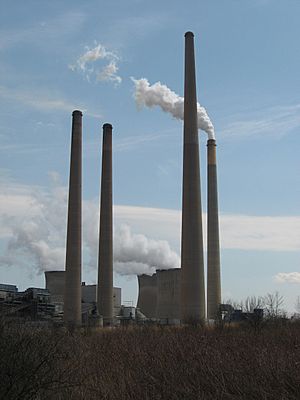Homer City Generating Station facts for kids
Quick facts for kids Homer City Generating Station |
|
|---|---|
 |
|
| Country | United States |
| Location | Center Township, Indiana County, Pennsylvania |
| Coordinates | 40°30′39″N 79°11′37″W / 40.51083°N 79.19361°W |
| Status | Operational |
| Commission date | Units 1–2: 1969 Unit 3: 1977 |
| Owner(s) | General Electric |
The Homer City Generating Station is a very large power plant in Indiana County, Pennsylvania, USA. It uses coal to make electricity. This power station is near a town called Homer City, Pennsylvania.
It can produce about 2 gigawatts (GW) of power. That's enough electricity to power two million homes! The plant is mostly owned by General Electric. About 260 people work there.
The first two parts of the plant, called Units 1 and 2, started working in 1969. Each of these units can make 660 MWe of power. A third part, Unit 3, started in 1977 and can make 692 MWe.
Contents
Where is the Power Plant Located?
The Homer City Generating Station is in Center Township, Indiana County, Pennsylvania. It covers a huge area of about 2,400 acres (9.7 square kilometers).
The site also has a large lake called the Two Lick Reservoir. This lake is about 1,800 acres (7.3 square kilometers) big. The power station uses this reservoir to help with its operations.
How the Plant Gets Its Coal
The Homer City Generating Station uses a type of coal called bituminous coal. This coal is brought to the plant by trucks and trains.
In the past, the plant mainly used coal from local mines in Pennsylvania. This coal was cleaned right at the power station. Now, more coal is brought in by train because local mines produce less.
A special device called a flue-gas desulfurization unit, or "scrubber," was added to Unit 3. This scrubber helps the plant burn local coal more cleanly.
A Look at the Plant's History
The Homer City power plant was built in the 1960s. It was first built by a company called Pennsylvania Electric Co. (PenElec) and other partners.
- 1969: Units 1 and 2 began making electricity.
- 1977: Unit 3 started operating.
Over the years, the plant's ownership changed a few times. In 2001, General Electric bought the plant. They then leased it back to another company called Edison. Later, Edison decided to give full control of the plant back to General Electric in 2012. General Electric then hired a company called NRG to run the plant.
How the Plant Uses Water
The power plant needs a lot of water for its operations. This water comes from the Two Lick Creek.
Here's how the water is used:
- Water is taken from Two Lick Creek.
- It goes through special cleaning systems.
- The water is used in the plant's boilers and for cooling.
- After use, the water is treated again to make it clean.
- Finally, the treated water is returned to Two Lick Creek and Blacklick Creek.
These creeks eventually flow into bigger rivers like the Conemaugh River and the Allegheny River.
Reducing Pollution from the Plant
Power plants that burn coal can release pollution into the air and water. The Homer City Generating Station has worked to reduce its pollution.
In 1998, a "scrubber" was added to help clean the air. This helped to reduce the amount of mercury released. More anti-pollution equipment was added starting in 2012 to make the plant even cleaner.
Sulfur Dioxide (SO2) Pollution
Sulfur dioxide (SO2) is a gas that can cause acid rain and breathing problems.
- In 1995, the plant released a lot of SO2.
- By 2003, it was one of the biggest SO2 polluters in the nation.
- However, with the new scrubbers, the plant has greatly reduced its SO2 emissions. In 2005, it released much less SO2 than before. These scrubbers are making it one of the cleanest coal plants.
Water Pollution Concerns
In 2007, the plant was fined for releasing too much of certain chemicals into the water. These chemicals included selenium and other substances from its wastewater. The plant also had issues with stormwater runoff. The Pennsylvania Department of Environmental Protection (DEP) worked with the plant to fix these problems.
Nitrogen Oxides (NOx)
Nitrogen oxides (NOx) are gases that contribute to smog and ozone pollution.
- In 2000 and 2001, the plant installed special technology called Selective Catalytic Reduction.
- This technology helped reduce NOx emissions by a lot, up to 83%.
- However, in recent years, the NOx emissions have sometimes increased again, even when the plant produced less electricity.
The Tall Chimney
Unit 3 at the Homer City power plant has a very tall chimney. It was built in 1977.
- This chimney is 371 meters (1,217 feet) tall.
- It is the third-tallest chimney in the world.
- It is the second-tallest in North America.
- It is the tallest chimney in the United States.
On clear days, you can see this huge chimney from far away towns like Greensburg, Pennsylvania and Ebensburg, Pennsylvania. Even though it's so tall, this specific chimney is no longer used for the plant's main operations. The gases from Unit 3 now go through a newer system that cleans them even more.
Images for kids




